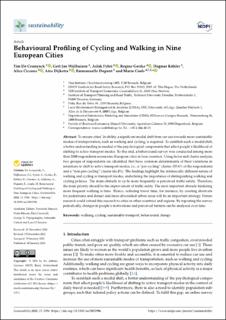| dc.contributor.author | De Ceunynck, Tim | |
| dc.contributor.author | Wijlhuizen, Gert Jan | |
| dc.contributor.author | Fyhri, Aslak | |
| dc.contributor.author | Gerike, Regine | |
| dc.contributor.author | Köhler, Dagmar | |
| dc.contributor.author | Ciccone, Alice | |
| dc.contributor.author | Dijkstra, Atze | |
| dc.contributor.author | Dupont, Emmanuelle | |
| dc.contributor.author | Cools, Mario | |
| dc.date.accessioned | 2023-06-13T09:00:25Z | |
| dc.date.available | 2023-06-13T09:00:25Z | |
| dc.date.created | 2023-01-23T12:30:18Z | |
| dc.date.issued | 2023-01-20 | |
| dc.identifier.issn | 2071-1050 | |
| dc.identifier.uri | https://hdl.handle.net/11250/3071079 | |
| dc.description | This article is an open access article distributed under the terms and conditions of the Creative Commons Attribution (CC BY) license (https://creativecommons.org/licenses/by/4.0/). | en_US |
| dc.description.abstract | To ensure cities’ livability, a significant modal shift from car use towards more sustainable modes of transportation, such as walking and cycling, is required. To establish such a modal shift, a better understanding is needed of the psychological components that affect people’s likelihood of shifting to active transport modes. To this end, a behavioural survey was conducted among more than 2000 respondents across nine European cities in four countries. Using factor and cluster analysis, two groups of respondents are identified that have common determinants of their variations in intentions to shift to active transport modes, i.e., a “pro-cycling” cluster (55.6% of the respondents) and a “non-pro-cycling” cluster (44.4%). The findings highlight the intrinsically different nature of walking and cycling as transport modes, underlining the importance of distinguishing walking and cycling policies. The main obstacle to cycle more frequently is perceived traffic safety. Therefore, the main priority should be the improvement of traffic safety. The most important obstacle hindering more frequent walking is time. Hence, reducing travel time, for instance, by creating shortcuts for pedestrians and denser and more diversified urban areas will be an important strategy. Future research could extend this research to cities in other countries and regions. By repeating the survey periodically, changes in people’s motivations and perceived barriers can be analysed over time. | en_US |
| dc.description.abstract | Behavioural Profiling of Cycling and Walking in Nine European Cities | en_US |
| dc.language.iso | eng | en_US |
| dc.publisher | MDPI | en_US |
| dc.rights | Navngivelse 4.0 Internasjonal | * |
| dc.rights.uri | http://creativecommons.org/licenses/by/4.0/deed.no | * |
| dc.title | Behavioural Profiling of Cycling and Walking in Nine European Cities | en_US |
| dc.title.alternative | Behavioural Profiling of Cycling and Walking in Nine European Cities | en_US |
| dc.type | Journal article | en_US |
| dc.type | Peer reviewed | en_US |
| dc.rights.holder | © 2022 by the authors. Licensee MDPI, Basel, Switzerland. | en_US |
| dc.description.version | publishedVersion | en_US |
| cristin.ispublished | true | |
| cristin.fulltext | original | |
| cristin.qualitycode | 1 | |
| dc.identifier.doi | 10.3390/su15031996 | |
| dc.identifier.cristin | 2113174 | |
| dc.source.journal | Sustainability | en_US |
| dc.source.volume | 15 | en_US |
| dc.source.issue | 3 | en_US |
| dc.source.pagenumber | 1-17 | en_US |

